Overview
The article titled “10 Essential Tools for Effective Fan Design in Engineering” identifies critical tools and technologies that enhance fan design efficiency and performance. It delves into advanced methodologies, including:
- Computational Fluid Dynamics (CFD)
- Computer-Aided Design (CAD)
- The integration of AI and machine learning
These technologies collectively optimize airflow, reduce energy consumption, and improve overall fan functionality, addressing the evolving demands of the engineering sector. By leveraging these tools, engineers can significantly enhance design outcomes and operational efficiency.
Introduction
In the rapidly evolving landscape of engineering, the significance of innovative fan design is paramount. As industries pursue enhanced efficiency and sustainability, the development of advanced cooling solutions has become a critical focus. Gagner-Toomey Associates leads this transformation, partnering with prominent manufacturers to deliver cutting-edge technologies that optimize performance across diverse applications. Through the integration of Computational Fluid Dynamics (CFD) and the utilization of Artificial Intelligence (AI) alongside machine learning, engineers are now equipped with powerful tools to refine fan designs.
This article explores the latest advancements in fan design techniques, illustrating how these innovations not only satisfy the rigorous demands of modern engineering but also pave the way for a more energy-efficient and sustainable future.
Gagner-Toomey Associates: Innovative Cooling Solutions for Fan Design
Gagner-Toomey Associates is at the forefront of innovative cooling solutions, integral to the efficient creation of fans in the electronics industry. By collaborating with a diverse array of manufacturers, including leaders in power, thermal management, timing, RF, and interconnect technologies, the company equips specialists with cutting-edge cooling solutions that markedly enhance product performance.
The industrial cooling systems market is anticipated to expand from $157.26 billion in 2024 to $220 billion by 2035, reflecting a compound annual growth rate (CAGR) of 3.1% from 2025 to 2035. This growth is propelled by increasing energy efficiency regulations and urbanization, positioning Gagner-Toomey as a pivotal player in tackling the intricate challenges of fan design development.
The emphasis on advanced cooling technologies not only adheres to current environmental regulations but also fosters innovation, enabling specialists to design efficient and reliable fan design systems tailored to the evolving market demands. Gagner-Toomey’s consultative approach, exceptional customer support, and strong distributor connections further enhance their ability to assist professionals in navigating these challenges.
As Trane emphasizes, “Innovation in cooling technologies is essential for meeting the challenges of today’s market,” highlighting the critical role Gagner-Toomey plays in this dynamic landscape.
Advanced Ceiling Fan Design Tools: Enhancing Performance and Efficiency
Advanced fan design tools, such as simulation software and performance calculators, are indispensable for optimizing ceiling fan efficiency. These technologies enable engineers to accurately model airflow patterns, assess energy consumption, and predict noise levels.
For example, research demonstrates that increasing blade length in axial fans significantly enhances flow patterns, subsequently improving pressure and efficiency characteristics. Notably, statistics reveal that ceiling fan power consumption varies from 2 to 20 W for a 1.32 m diameter model and from 4 to 53 W for a 2.13 m diameter model, providing critical insights into energy metrics relevant to fan design.
A significant case study showcased how Computational Fluid Dynamics (CFD) was employed to develop a prototype cleaning fan, resulting in improved airflow uniformity and reduced eddy currents, ultimately enhancing functionality and extending service life. Furthermore, the reduction of noise levels resulting from fan improvements has been shown to create a more conducive working environment for employees.
Statistics indicate a growing trend in the use of simulation software among engineers, with many reporting notable enhancements in fan efficiency metrics. As Dr. Manuel Fritsche, a leading expert in flow simulations, remarked, “It contributes to climate protection.”
By harnessing these advanced tools, designers can create fan designs that not only meet but exceed expectations, ensuring optimal airflow and energy efficiency across various applications. Additionally, findings from recent research can aid in addressing common inquiries designers have regarding fan effectiveness.
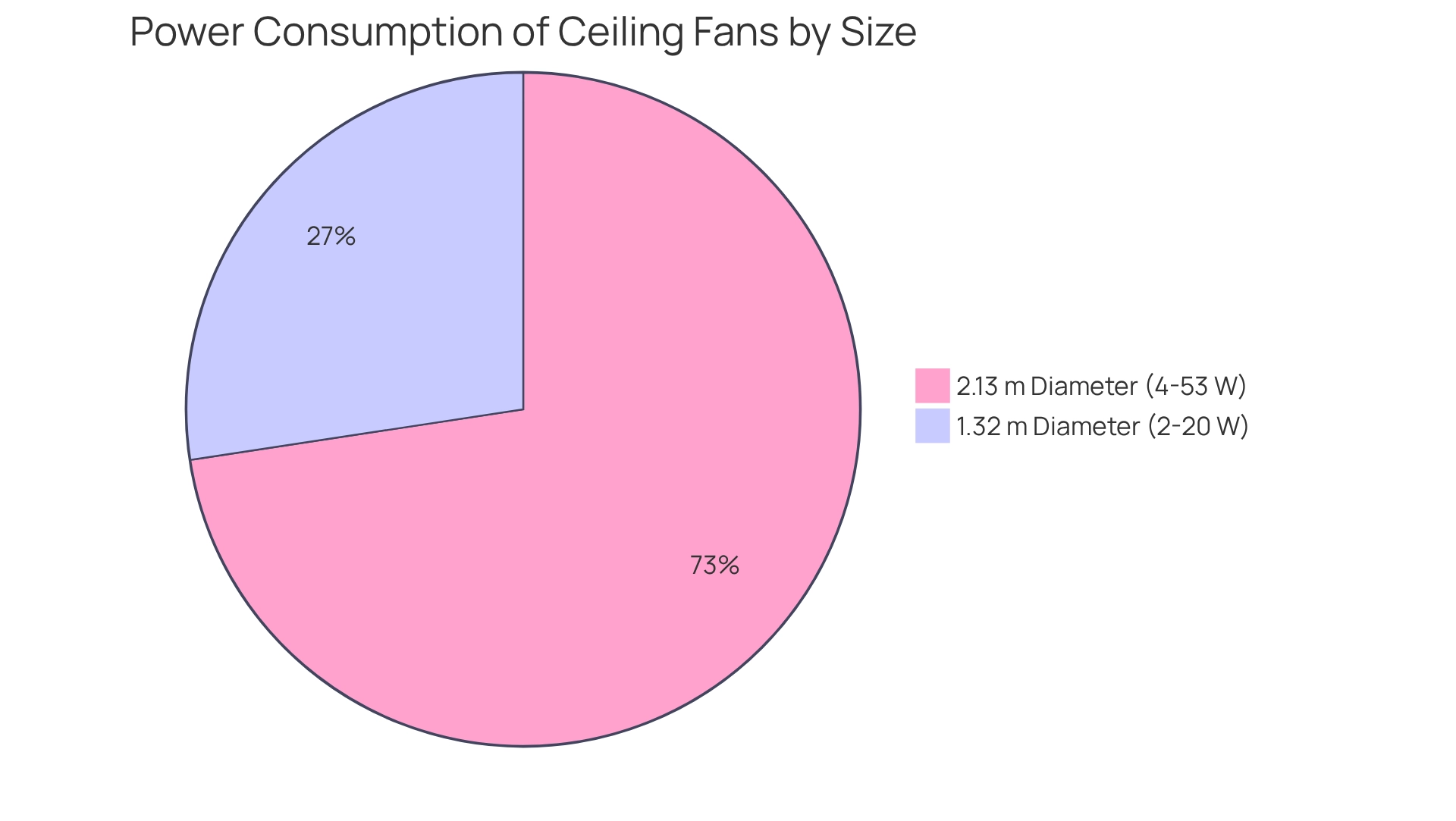
Computational Fluid Dynamics (CFD): Optimizing Fan Performance
Computational Fluid Dynamics (CFD) is an indispensable tool in the optimization of fan efficiency, enabling engineers to simulate airflow and pressure distribution with exceptional precision. This technology not only identifies flaws in design layouts but also enhances overall efficiency by facilitating the examination of various parameters such as blade shape and angle. Notably, research has shown that increasing inlet air speed can lead to significant reductions in average relative CO concentration by 32% and 65%, respectively. This underscores the profound impact of airflow dynamics on efficiency metrics.
Furthermore, a comprehensive CFD methodology has been effectively applied in vehicle cooling systems, illustrating how thorough analysis can refine cooling configurations, boost efficiency, and minimize noise emissions. As highlighted by Tesfaye Kebede Ali, analyzing shaft speed has resulted in improvements in flow rate and outlet total pressure that are directly proportional to input power and shaft speed, emphasizing the critical role of CFD in optimizing fan efficiency.
As the industry continues to evolve, the adoption of advanced CFD techniques remains pivotal in enhancing the efficiency of fan design, establishing it as a vital resource for professionals striving to meet stringent performance standards. The integration of CFD not only elevates airflow rates but also plays a crucial role in energy conservation and noise reduction, reinforcing its significance in fan design for high-performance fans that meet contemporary engineering demands.
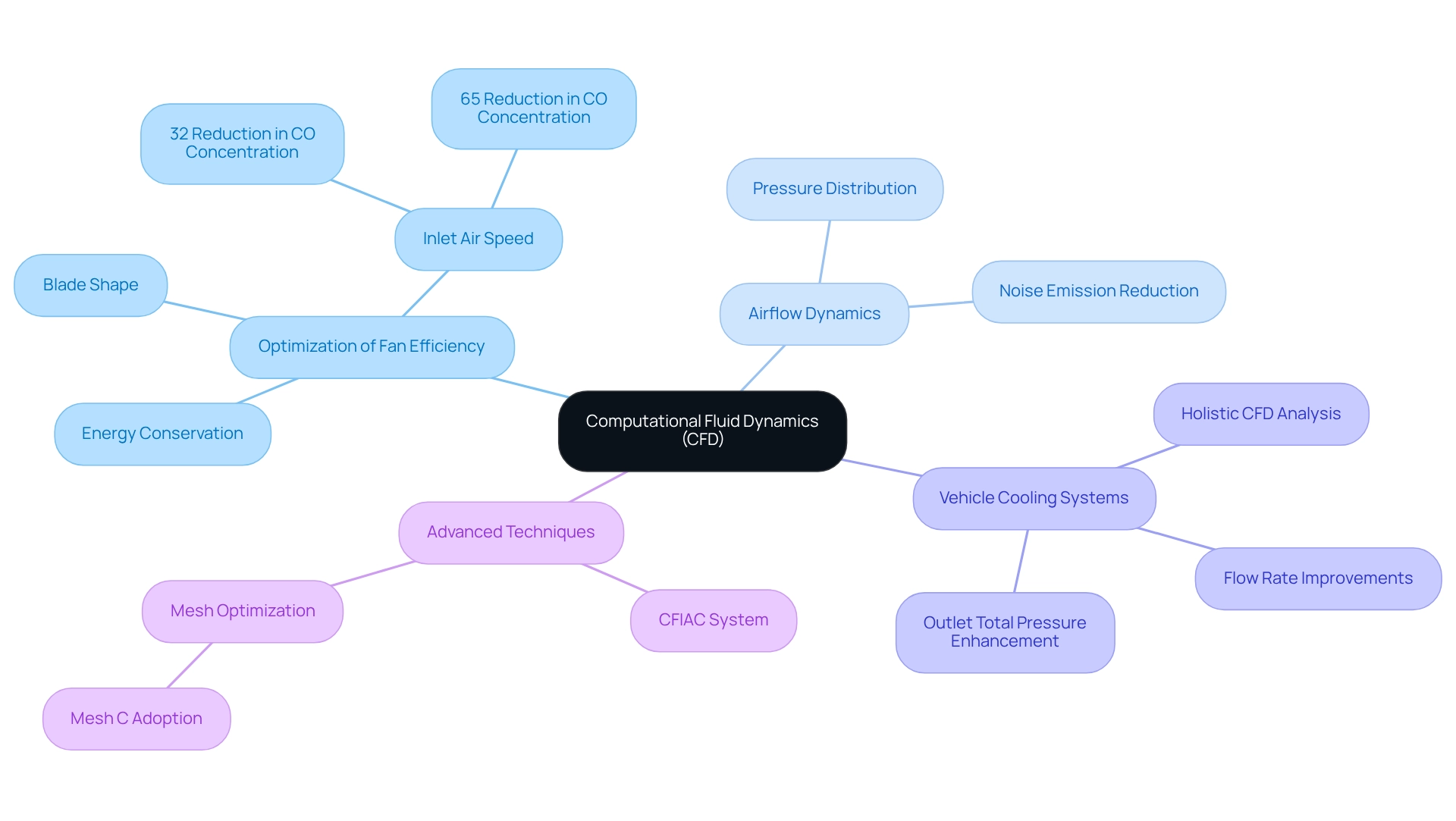
Computer-Aided Design (CAD): Essential for Accurate Fan Modeling
Computer-Aided Design (CAD) software is indispensable for precise fan design, enabling engineers to develop intricate 3D models of fan components. This capability allows for exact measurements and modifications, ensuring that plans meet specific performance criteria. CAD tools significantly streamline the creation process, facilitating quick prototyping and iterative testing—both essential for enhancing fan models.
By leveraging CAD, designers can optimize their fan design models for functionality and manufacturability, ultimately boosting the success of their prototyping efforts. Notably, 65% of professionals face challenges in exchanging models across different CAD platforms, underscoring the importance of selecting appropriate tools that foster teamwork and efficiency in fan design projects.
As Christof Baron, CEO, remarked, “Statista is a great source of knowledge, and pretty helpful to manage the daily work,” emphasizing the crucial role of CAD tools in daily engineering tasks. Furthermore, as the CAD market evolves—with key players like Autodesk and Dassault Systèmes leading the way—the integration of cloud-based solutions and AI is set to transform how professionals approach fan design and creation by 2025. This competitive landscape illustrates the continuous innovation in CAD tools, which is vital for addressing the demands of modern engineering.

Parametric Design Capabilities: Customizing Fan Designs for Optimal Results
Parametric capabilities empower engineers to customize fan design configurations, effectively meeting specific efficiency standards. By adjusting parameters such as blade length, pitch, and curvature, designers can significantly enhance airflow and efficiency across a variety of applications. This flexibility not only boosts fan performance but also underscores the importance of fan design, allowing for rapid adjustments to evolving requirements in contemporary fan development.
For instance, a recent study on local thermal comfort in non-uniform building environments illustrated how tailored fan design can optimize thermal comfort, resulting in improved user experiences. Furthermore, aligning thermal comfort models with HVAC controls has demonstrated energy savings exceeding 10%, showcasing the concrete advantages of precision in fan engineering.
Notably, a dedicated collector positioned near the dust source would consume approximately 20% more energy compared to the 74% needed for a collector operating at increased fan speed, highlighting the essential role of performance optimization in energy efficiency.
As industry experts assert, “All these possible solutions may represent a higher initial cost, but when the energy savings is considered, any can provide overall long-term savings,” as stated by Bart van de Velde. This trend towards customization is increasingly apparent in 2025, with developers leveraging parametric tools to create innovative solutions in fan design that cater to the demands of modern applications.
Moreover, ACI’s fan engineers offer valuable insights on fan engineering challenges, emphasizing the critical role of expert guidance in achieving optimal fan performance.

AI and Machine Learning: Revolutionizing Fan Design Techniques
Artificial Intelligence (AI) and machine learning are fundamentally transforming fan design methodologies through the power of predictive analytics and automated optimization. These advanced technologies analyze extensive datasets to reveal patterns and suggest improvements, leading to a substantial decrease in development timelines. By incorporating AI into the creation workflow, professionals are empowered to develop smarter, more efficient fan designs that dynamically adapt to varying operational conditions, thereby enhancing overall performance.
For instance, predictive analytics facilitates real-time adjustments based on environmental factors, ensuring optimal functionality and energy efficiency. As we progress into 2025, the integration of AI in fan design not only streamlines engineering processes but also boosts efficiency, paving the way for innovative solutions that meet the evolving demands of the electronics industry.
According to Stephen Hawking, success in creating AI could be the most significant event in human history, underscoring the importance of responsible integration of these technologies. Furthermore, Claude Shannon’s vision of a future where humans and robots coexist indicates that the relationship between creators and AI will be crucial in shaping the future of fan design.
As professionals in technology embrace these advancements, they must also consider ethical frameworks, such as Isaac Asimov’s Three Laws of Robotics, to guide their responsibilities in this rapidly evolving field.
Collaboration and Sharing: Key to Innovative Fan Design Solutions
Collaboration and the exchange of ideas are paramount for fostering innovation in fan creation solutions. Current collaborative tools, such as cloud-based creation platforms and project management software, are equipped with features that enhance teamwork, enabling multiple engineers to collaborate on projects in real-time. This collaborative approach not only stimulates creativity but also results in more robust solutions, as diverse viewpoints enhance problem-solving skills and drive innovation in fan design technology.
Research indicates that teams engaging in collaboration are 33% more likely to complete projects on time, underscoring the importance of effective communication and shared objectives in engineering. Furthermore, well-structured collaborative environments can boost individual productivity by 25%, demonstrating that the right tools and spaces can significantly impact the success of initiatives related to fan design.
For instance, collaborative workspaces specifically designed for engineering teams can facilitate interaction and idea-sharing, directly benefiting projects related to fan design. As the industry evolves, leveraging collaboration tools, such as virtual whiteboards and integrated creative software, will be essential for engineers aiming to advance fan design and deliver innovative solutions. Additionally, involving a diverse range of stakeholders in cooperative AI development can further enrich the creation process, ensuring that a wide array of insights and expertise is considered.

Industry Impact: How Fan Design Techniques Influence Multiple Sectors
Fan creation techniques are essential for enhancing efficiency and performance across diverse sectors, including HVAC, automotive, and electronics. Efficient fan systems not only yield significant energy savings but also elevate user comfort and operational effectiveness. For instance, studies reveal that the average cooling energy consumption in fan conditions is approximately 25 kWh/m²·yr, underscoring the potential for energy efficiency improvements through optimized fan configurations. This statistic emphasizes the necessity of integrating effective fan solutions to mitigate energy consumption across various applications.
In the HVAC sector, advanced fan design has shown a marked improvement in thermal comfort within buildings that struggle to achieve high satisfaction levels. As noted by Michael G. Kent, “Our result also highlighted the incongruence between thermal preferences and satisfaction responses given by occupants.” A case study assessing the energy use intensity of air conditioning and mechanical ventilation (ACMV) systems indicated that energy consumption was significantly lower at elevated setpoint temperatures when fans were effectively employed. This illustrates the efficiency gains that can be realized through strategic fan integration.
Furthermore, the automotive industry is experiencing analogous advantages, with data suggesting that improved fan design can lead to considerable energy savings. A recent case study illustrated that the implementation of efficient fan systems in automotive applications not only met regulatory standards but also substantially reduced energy usage, aligning with consumer demands for sustainability and effectiveness. As sectors continue to evolve, the impact of fan creation methods on energy conservation and overall system efficiency remains a critical focus for product development in 2025 and beyond, particularly for electronics engineers striving to enhance cooling solutions in their projects.
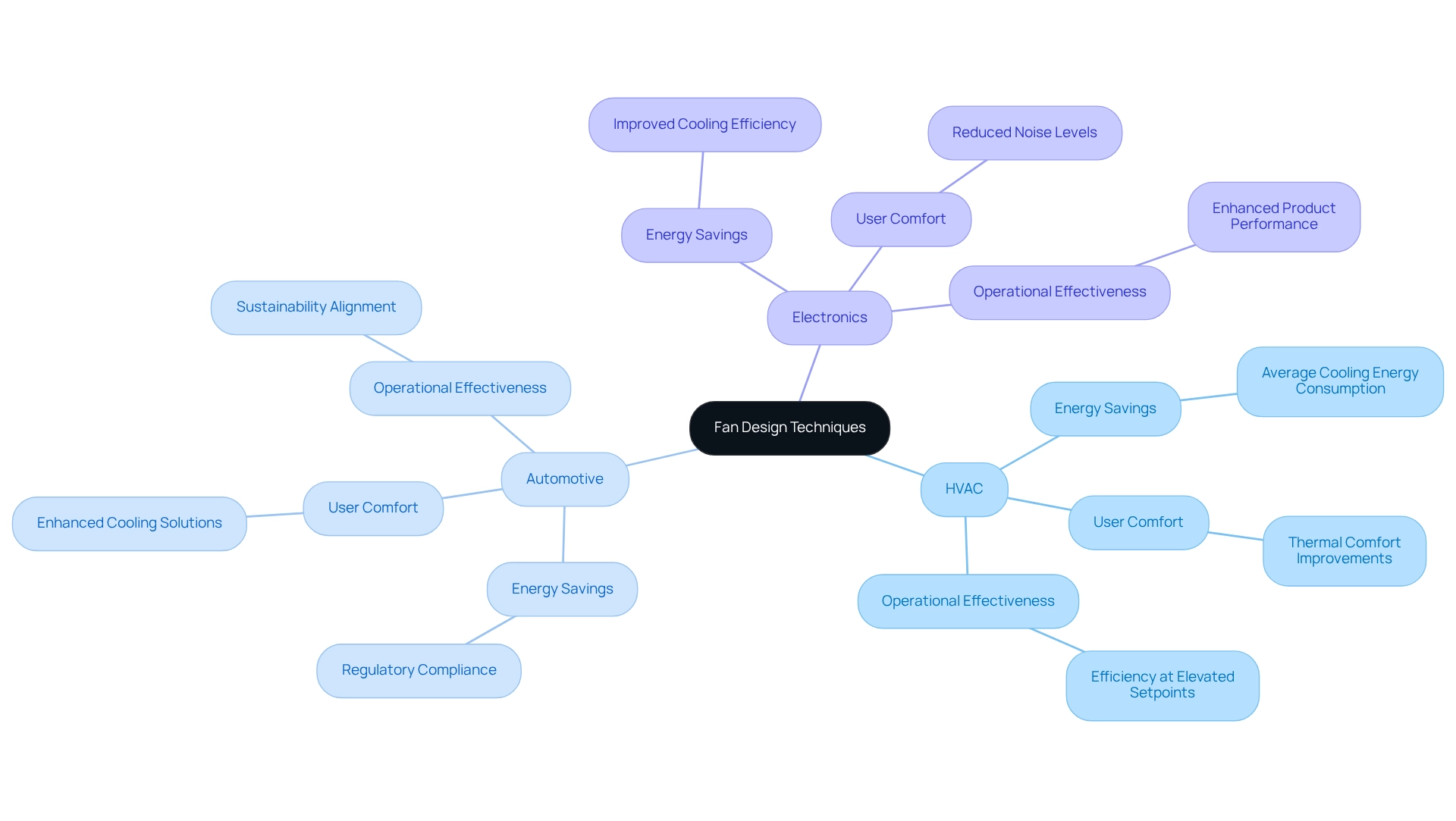
Future Trends in Fan Design: What Engineers Need to Know
Future trends in fan creation are increasingly influenced by the incorporation of smart technologies, a greater focus on sustainability, and notable progress in materials science. Engineers must recognize the escalating demand for energy-efficient solutions, particularly as the Internet of Things (IoT) continues to revolutionize fan systems. Intelligent devices outfitted with sensors can optimize performance by modifying speed according to environmental factors, thus improving energy efficiency and user comfort.
As we approach 2025, the emphasis on sustainability will propel innovations in ventilation systems, utilizing materials that not only lessen environmental impact but also enhance performance. The adoption of recyclable materials and energy-efficient manufacturing processes will become standard practice, aligning with global sustainability goals.
Moreover, real-world examples of smart technologies in fan systems are emerging, showcasing how IoT can enhance functionality. Fans that interact with building management systems can deliver immediate information on energy usage and operational effectiveness, enabling proactive maintenance and minimized downtime. Expert insights emphasize that the future of fan design will include a collaborative method, where specialists work closely with manufacturers to create solutions that are not only inventive but also practical and market-ready. By embracing these trends, engineers can develop cutting-edge products that meet the evolving demands of consumers and industries, ensuring they remain at the forefront of technological advancement in the electronics sector.
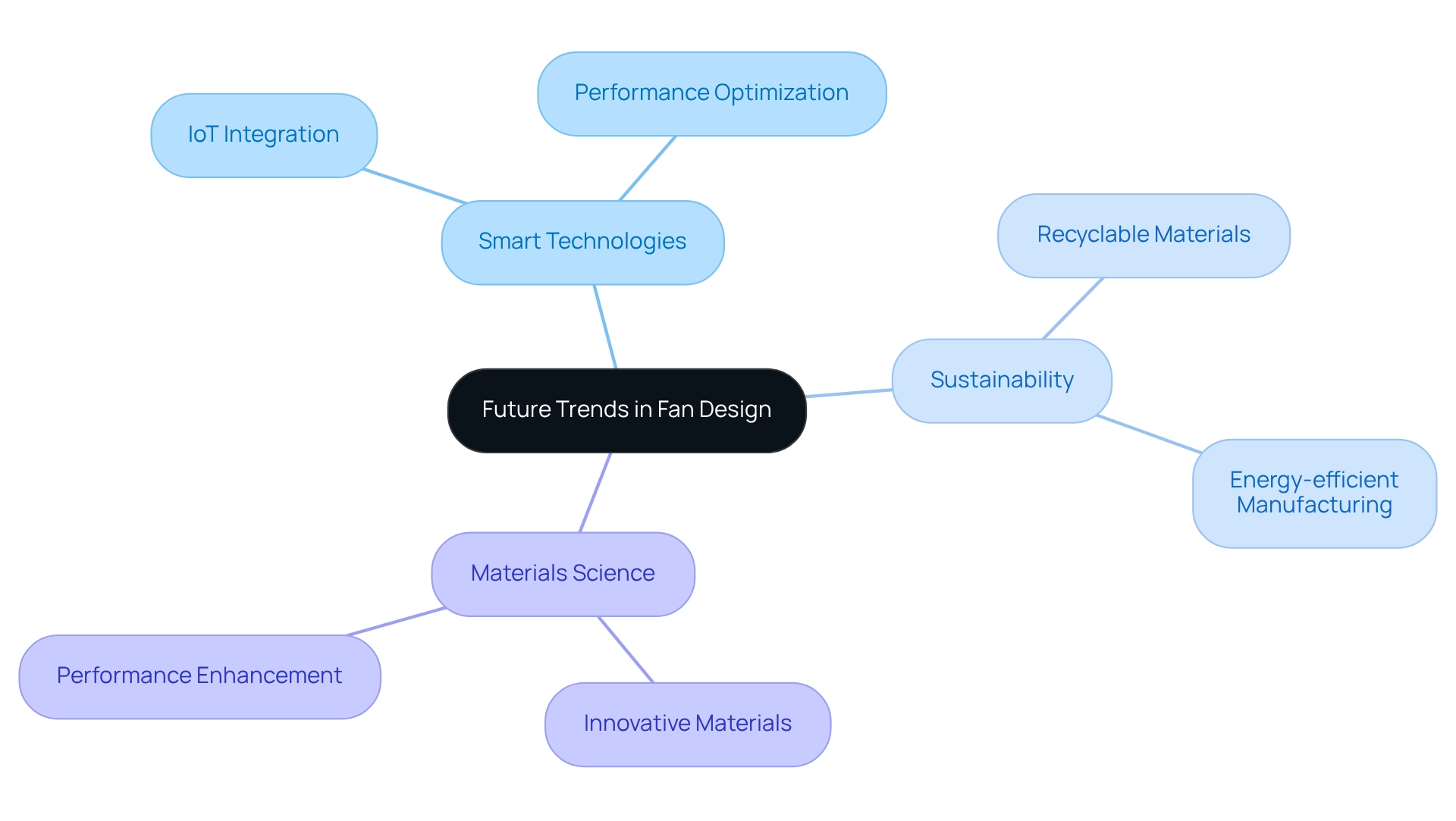
Selecting the Right Fan Specifications: A Guide for Engineers
Choosing suitable fan design specifications is crucial for enhancing functionality and efficiency in engineering applications. Gagner-Toomey Associates, the world’s largest producer of standard and custom air-movers, offers an extensive range of DC input Tube Axial devices and Centrifugal Blowers, meticulously designed for superior performance, efficiency, and low noise.
Key factors to consider encompass:
- Airflow requirements
- Noise levels
- Energy efficiency
Engineers must critically evaluate the specific demands of their projects, taking into account the operational environment and conditions. For example, in large data centers, where tens of thousands of servers may each utilize between 10 and 50 fans, a comprehensive understanding of airflow dynamics becomes essential. This understanding of fan design includes not only static pressure but also total and velocity pressure, which are vital for effective fan operation.
Moreover, aligning fan design with sustainability goals and regulatory standards is increasingly paramount. Gagner-Toomey Associates provides valuable tools and resources for technical support and product selection, thereby enhancing professionals’ decision-making processes. By leveraging their comprehensive support options, professionals can optimize fan performance through meticulous analysis of specifications and airflow requirements, resulting in improved energy efficiency and reduced operational costs.
As we progress through 2025, staying informed about the latest advancements in fan technology and fan design will empower engineers to make informed choices that propel innovation in their projects.
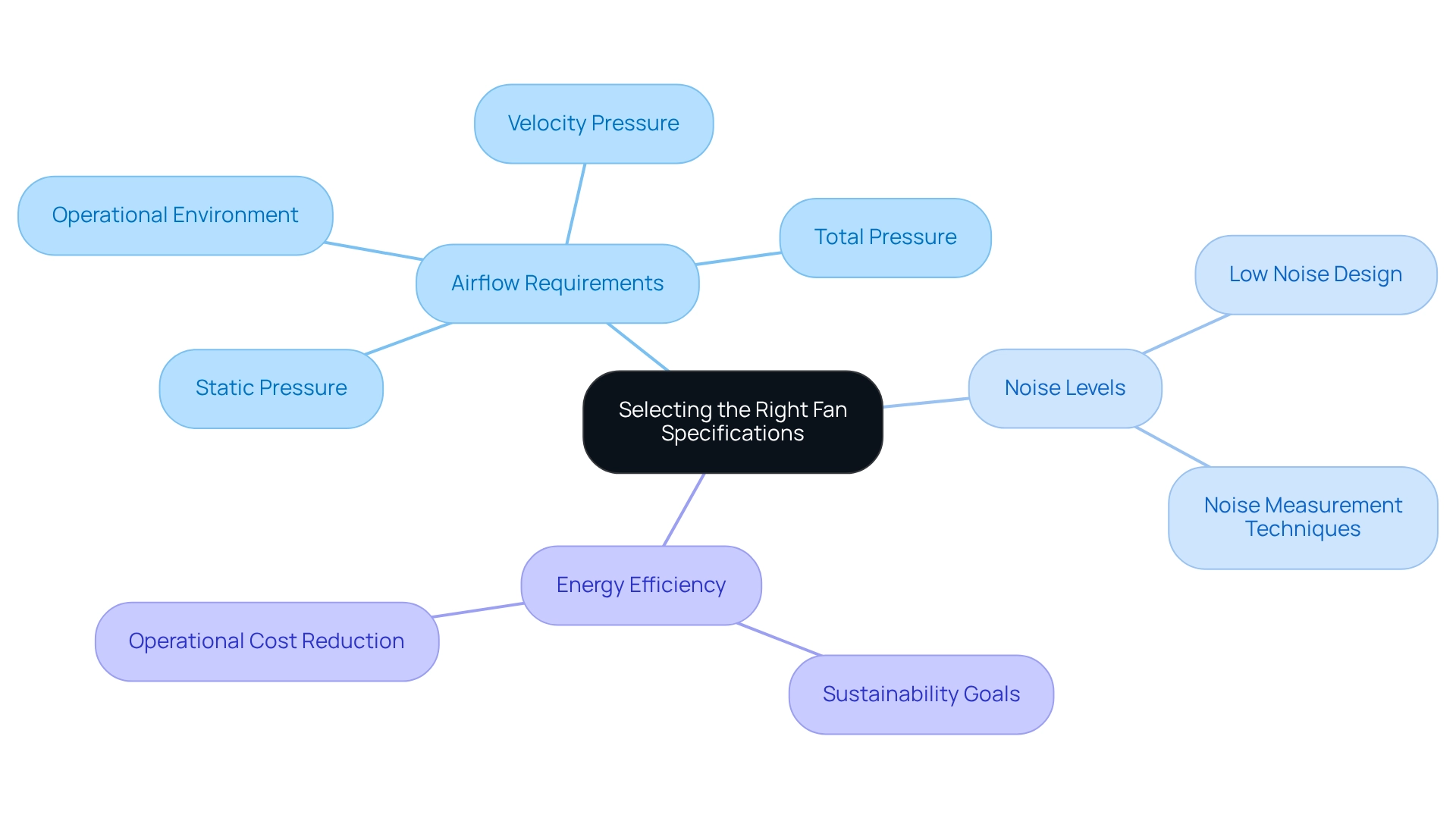
Conclusion
Innovative fan design is revolutionizing the engineering landscape, with Gagner-Toomey Associates at the forefront, delivering advanced cooling solutions that significantly enhance performance across diverse industries. The incorporation of technologies such as Computational Fluid Dynamics (CFD), Computer-Aided Design (CAD), and artificial intelligence empowers engineers to optimize fan efficiency, minimize energy consumption, and elevate user comfort. As the demand for energy-efficient and sustainable solutions escalates, the importance of these advanced design tools becomes increasingly paramount.
The article underscores how collaboration and the exchange of ideas can propel innovation in fan design, enabling engineers to confront complex challenges and develop cutting-edge solutions. By utilizing parametric design capabilities and smart technologies, engineers can customize designs to fulfill specific performance criteria while also aligning with shifting market demands and sustainability objectives. As industries increasingly emphasize energy efficiency, advancements in fan design techniques will be crucial in shaping future applications across HVAC, automotive, and electronics sectors.
As engineers brace for the challenges and opportunities that lie ahead, grasping the latest trends and technologies in fan design will be vital for fostering innovation and realizing optimal outcomes. By embracing these advancements, they can contribute to a more energy-efficient and sustainable future, ensuring that their designs meet the stringent demands of modern engineering while enhancing overall performance and user satisfaction. The future of fan design is promising, driven by ingenuity and a steadfast commitment to excellence that will undoubtedly redefine industry standards in the years to come.
Frequently Asked Questions
What role does Gagner-Toomey Associates play in the cooling solutions industry?
Gagner-Toomey Associates is a leader in innovative cooling solutions, collaborating with various manufacturers to provide advanced cooling technologies that enhance product performance in the electronics industry.
What is the projected growth of the industrial cooling systems market?
The industrial cooling systems market is expected to grow from $157.26 billion in 2024 to $220 billion by 2035, reflecting a compound annual growth rate (CAGR) of 3.1% from 2025 to 2035.
What factors are driving the growth of the industrial cooling systems market?
The growth is driven by increasing energy efficiency regulations and urbanization, which present challenges in fan design development.
How does Gagner-Toomey support professionals in the cooling solutions field?
Gagner-Toomey offers a consultative approach, exceptional customer support, and strong distributor connections to help professionals navigate challenges in cooling solutions.
What advanced tools are important for optimizing ceiling fan efficiency?
Advanced fan design tools, such as simulation software and performance calculators, are essential for modeling airflow patterns, assessing energy consumption, and predicting noise levels.
How does blade length affect fan efficiency?
Research shows that increasing blade length in axial fans significantly improves flow patterns, enhancing pressure and efficiency characteristics.
What impact does Computational Fluid Dynamics (CFD) have on fan design?
CFD is crucial for optimizing fan efficiency as it allows engineers to simulate airflow and pressure distribution, identify design flaws, and improve overall efficiency.
What improvements can be achieved through CFD in cooling systems?
CFD has been effectively applied to refine cooling configurations, boost efficiency, and minimize noise emissions in various systems, including vehicle cooling systems.
How does airflow dynamics influence efficiency metrics?
Increasing inlet air speed can significantly reduce average relative CO concentration, demonstrating the impact of airflow dynamics on overall efficiency.
Why is the adoption of advanced CFD techniques important for fan design?
Advanced CFD techniques are vital for enhancing fan design efficiency, energy conservation, and noise reduction, helping professionals meet stringent performance standards.

